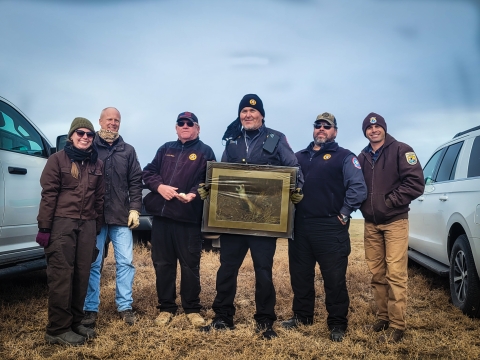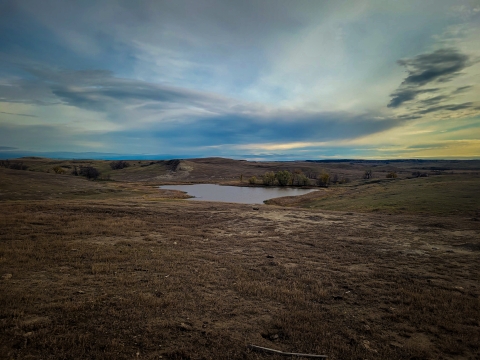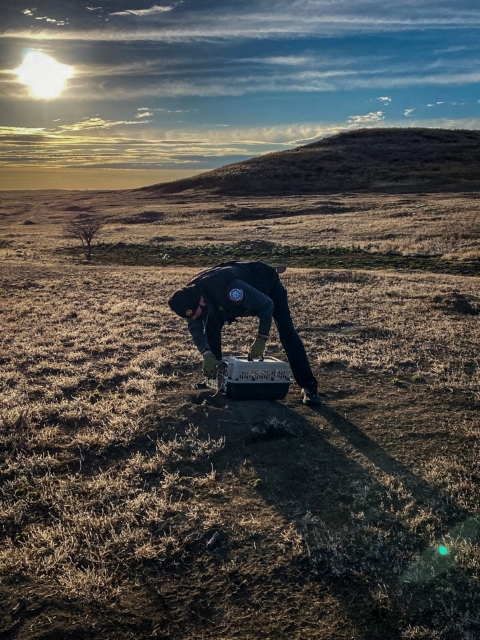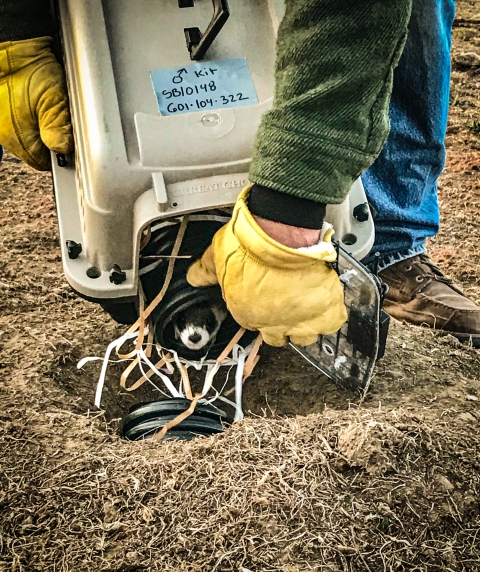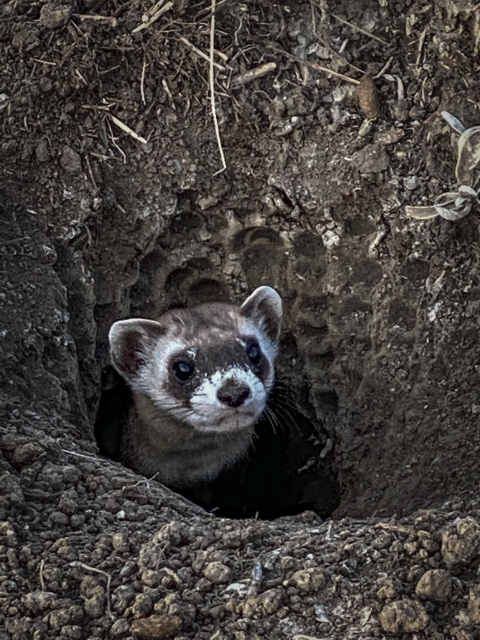The black-footed ferret once roamed the landscape of the Standing Rock Sioux Tribe’s reservation in North and South Dakota. This species has been listed as endangered since 1967. Black-footed ferrets were feared extinct in 1981 before a remnant population was discovered in Meeteetse, Wyoming. Today, black-footed ferret numbers are encouraging, but more reintroduction sites are needed to recover the species. Beginning in Wyoming, reintroduction efforts have since expanded to sites in Montana, South Dakota, Arizona, Colorado, Utah, New Mexico, Kansas, Canada, and Mexico. Tribal partners have been instrumental and have played an out-sized role in black-footed ferret recovery and reintroduction efforts, and the Standing Rock Sioux reservation has high quality grassland habitat, which is necessary for the ferret. The black-footed ferret relies on prairie dog colonies to survive as 90% of its diet consists of prairie dogs. Currently, prairie dogs occupy 2% of their overall historic range.
The Standing Rock Sioux have always valued and respected the black-footed ferret as an apex predator. Its services aid ecosystem health, including the management of prairie dog colonies, and it helps create a balanced ecosystem for all wildlife that live on and utilize prairie dog towns. Since 2013, Director of Standing Rock Game and Fish (SRGF) Jeff Kelly had dreamt about the return of the black-footed ferret on the reservation. He’d been on a mission for 8 years to bring the ferret back, and that dream finally turned into reality in October 2021.
With a renewed partnership, SRGF and U.S. Fish and Wildlife Service (USFWS) spent 2020 working together to return black-footed ferrets to the landscape. This effort began by mapping prairie dog colonies across the reservation for the first time since 2012; this was done as a means to quantify prairie dog acreage in order to gain an understanding of potential ferret habitat. Between schedules, one month was all the team had to map so the largest and most easily accessible prairie dog colonies on Tribal land (and with landowner permission) were targeted. A total of 8,565 acres were mapped during that one month.
Once the mapping was done, the next step was to identify if there was any suitable habitat for black-footed ferrets to be reintroduced. After much analysis between SRGF, USFWS (including the Black-footed ferret Conservation Center), Standing Rock Land Operations, and the Tribal Environmental Protection Agency, it was discovered that – YES! – there was suitable habitat where black-footed ferrets could potentially thrive.
Now that suitable habitat was identified, USFWS staff provided a reintroduction plan to the Standing Rock Sioux Tribal Council for review. With approval from the Tribal Council, the Standing Rock Sioux and USFWS would work together to bring black-footed ferrets back to the reservation. SRGF Ranger Waylon Little Eagle and USFWS’s Lauren Toivonen met with individuals living in or leasing land near the suitable habitat to discuss the black-footed ferret reintroduction plan and received support of the effort.
After informing stakeholders, a Safe Harbor Agreement was signed. This agreement is a voluntary conservation tool for private landowners, including Tribes, who wish to support recovery of plants and animals listed under the Endangered Species Act.
The long-awaited moment finally arrived! 28 black-footed ferrets (16 male and 12 female) embarked on a hefty journey via SUV from the National Black-footed Ferret Conservation Center in Colorado, to McIntosh, South Dakota. Surrounded by a team of excited Tribal and community members and SRGF and USFWS biologists, the first black-footed ferret was reintroduced onto Standing Rock Sioux lands on October 20, 2021 – 1.5 years after the partnership between SRGF and USFWS reformed. While the ferret might not have understood the significance surrounding its presence, it began exploring its new home.
The team then broke off into 3 groups to release the remaining 27 black-footed ferrets across 5 different areas of suitable habitat. It was forecasted to be a drab, rainy day, but Mother Nature had other plans for this special moment. It ended up being a beautiful, sunny day that would go down in history for the Standing Rock Sioux Tribe as one of America’s most iconic species, the black-footed ferret, was finally brought back home.
October 2022 Update!
To continue building the black-footed ferret population, a new release took place at the Standing Rock Reservation on October 26, 2022. Standing Rock Sioux Tribal members including Game and Fish Director Jeff Kelly, Kenel District Councilman Delray Demery, Kerry Libby, Standing Rock External Affairs Director, Gary Weasel, Standing Rock SRO, and USFWS staff all came together for the exciting opportunity to bring more black-footed ferrets to their new home.
Councilman Demery expressed how incredible it was to take part in an event of such magnitude helping balance the prairie dog populations and provide habitat for an endangered species. This was the first time he’d seen a black-footed ferret outside of taxidermy and photos and he stated that it was an honor to be part of.
“If the ferret population is a success, I can actually say I took part in it, something important to our natural environment," said Councilman Delray Demery
The Standing Rock Sioux Tribe expressed a similar sentiment at the importance of releasing black-footed ferrets on the reservation. They value and respect the black-footed ferret and the benefits it can provide to their beloved ecosystem. Standing Rock Game and Fish Director, Jeff Kelly, stated, “The U.S. Fish and Wildlife Service releases approximately 200 [black-footed ferrets] every year and of that, Standing Rock received 26. Our hope is that these adults released will repopulate and thrive in their new environment. Working with the Fish and Wildlife Service on this is an honor, and testament that our last release of ferrets was successful, having another release done this year.”
The Chairwoman of the Standing Rock Sioux Tribe said, “I am so happy and congratulate Jeff Kelly and our Game and Fish Department with their partnership with the U.S. Fish and Wildlife Service to integrate this little relative of ours. I love that this integration and introduction is to complete the circle of life in a good way, without poison, which hurts not only the prairie dog, but all the predators that rely on the prairie dog for their survival. Balance is the ultimate goal.”
With another exciting black-footed ferret release on the reservation, the work doesn’t end there. USFWS will continue working alongside the Standing Rock Sioux to monitor the ferret populations and we hope to see continued success.

